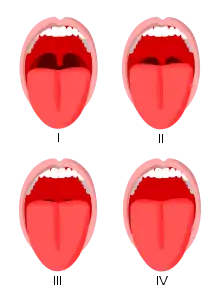Simplified Airway Risk Index
The Simplified Airway Risk Index (or SARI) is a multivariate risk score for predicting difficult tracheal intubation. The SARI score ranges from 0 to 12 points, where a higher number of points indicates a more difficult airway. A SARI score of 4 or above indicate a difficult intubation.[1] Seven parameters is used to calculate the SARI score: Mouth opening, thyromental distance, Mallampati score, movement of the neck, the ability to create an underbite, body weight and previous intubation history.[1]

Mallampati score. One of seven parameters used to calculate a SARI score
Calculation
- Mouth opening: A mouth opening greater than 4 centimeters between the incisors results in 0 points whereas a distance below results in 1 point.
- Thyromental distance:A thyromental distance greater than 6.5 centimeters results in 0 point whereas a distance between 6-6.5 centimeters is given 1 point and finally a distance below 6 centimeters is given 2 points.
- Mallampati score: Class I and II of the modified mallampati scoring results in 0 points whereas a class III is given 1 point and a class IV 2 points.
- Movement of the neck: The ability to move the neck more than 90 degrees results in 0 points whereas a movement range of 80-90 degrees results in 1 point and a movement range below 80 degrees results in 2 points.
- Underbite: If the patient is able to protrude the jaw enough to create an underbite a score of 0 is given if not 1 point.
- Body weight: A weight below 90 kilograms results in 0 points. A weight between 90 and 110 kilograms is given 1 point and a weight above 110 kilograms counts as 2 points.
- Previous intubation history: If the patient has previously been intubated without any difficulties, a score of 0 points is given. If the patient has not previously been intubated, is unsure whether there were any difficulties or no records can be produced, a score of 1 point is given. If there is a positive history of difficulties intubating 2 points is given.
| Parameter | 0 points | 1 point | 2 points | |
|---|---|---|---|---|
| 1 | Mouth opening | > 4 cm | <4 cm | |
| 2 | Thyromental Distance | >6.5 cm | 6 to 6.5 cm | <6 cm |
| 3 | Mallampati | I or II | III | IV |
| 4 | Neck movement | > 90° | 80 to 90° | < 80° |
| 5 | Underbite | Can protrude jaw | Cannot protrude jaw | |
| 6 | Body weight | < 90 kg | 90 to 110 kg | > 110 kg |
| 7 | Previous intubation history | No difficulty | Unsure or Unknown | Known difficulty |
| Score ≥ 4 - Predictor of difficult intubation |
See also
References
- Nørskov, Anders Kehlet; Rosenstock, Charlotte Valentin; Wetterslev, Jørn; Lundstrøm, Lars Hyldborg (23 October 2013). "Incidence of unanticipated difficult airway using an objective airway score versus a standard clinical airway assessment: the DIFFICAIR trial – trial protocol for a cluster randomized clinical trial" (PDF). Trials. 14 (347): 347. doi:10.1186/1745-6215-14-347. PMC 3842741. PMID 24152537. Retrieved 19 November 2014.
This article is issued from Wikipedia. The text is licensed under Creative Commons - Attribution - Sharealike. Additional terms may apply for the media files.